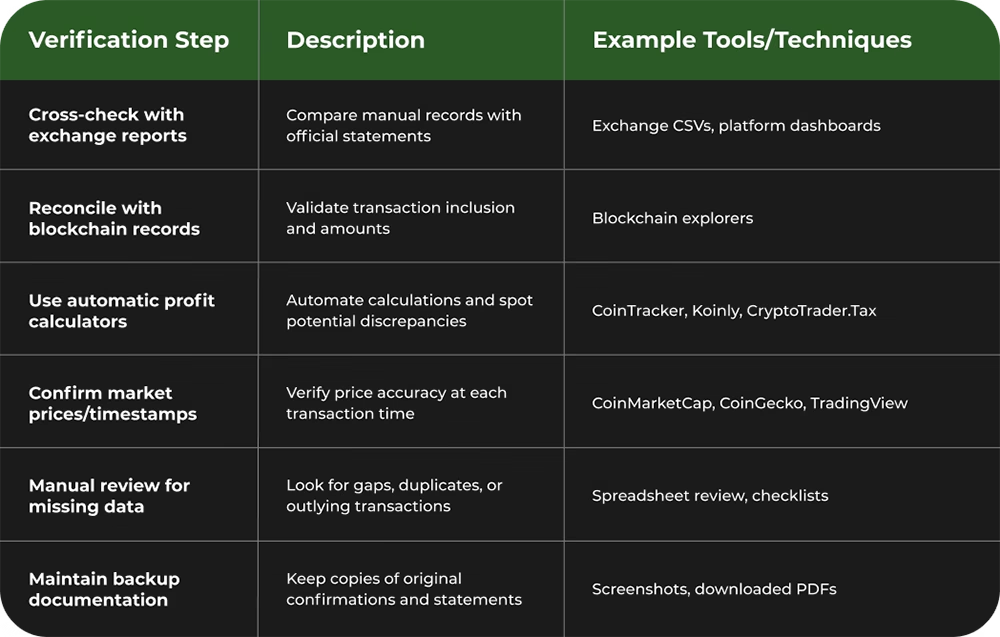Calculating your crypto profit might sound simple at first. Collect your transactions, do some math, and you’re done. But the numbers tell a different story. Up to 60 percent of crypto traders miss at least one key transaction per year, risking inaccurate profit calculations and steep penalties. Most never realize their biggest mistake is not what they expect. It is not about complex formulas or intricate trading strategies. The real difference comes down to the records you keep before you ever start counting.

Successfully calculating your crypto profit begins with meticulous transaction record collection. This foundational step determines the accuracy of your entire profit analysis and ensures you have a comprehensive view of your cryptocurrency financial activities.
To calculate crypto profit effectively, you need a complete record of every cryptocurrency transaction. This includes purchases, sales, trades, mining rewards, staking income, and transfers between wallets. Each transaction represents a potential taxable event that impacts your overall profit calculation.
Start by collecting transaction histories from all cryptocurrency exchanges where you have traded. Most reputable platforms like Coinbase, Binance, and Kraken provide downloadable transaction reports in CSV or Excel formats. These reports typically include critical details such as:
For traders using multiple exchanges or wallets, manual compilation becomes crucial. Use spreadsheet software like Microsoft Excel or Google Sheets to centralize your transaction records. Consider utilizing cryptocurrency tracking tools such as CoinTracker or Koinly, which can automatically aggregate transactions from multiple sources and simplify the record-keeping process.
According to the U.S. Internal Revenue Service, maintaining detailed transaction records is not just beneficial—it’s a legal requirement for accurate tax reporting. Comprehensive documentation protects you during potential audits and provides a clear financial trail of your cryptocurrency investments.
Pro tip: Screenshot and save original transaction confirmations as a backup. Digital records can sometimes be incomplete, so maintaining personal documentation adds an extra layer of verification for your crypto transactions.
After gathering your transaction data, the next critical step in calculating crypto profit is determining your cost basis. This foundational calculation represents the original value of your cryptocurrency at the time of acquisition and serves as the baseline for measuring potential gains or losses.
Cost basis represents the total amount you originally invested in a cryptocurrency, including the purchase price and any associated transaction fees. For crypto investors, this means tracking the exact price you paid for each unit of cryptocurrency at the moment of purchase. Unlike traditional stock investments, cryptocurrency transactions can be more complex due to frequent trading, multiple purchase points, and price volatility.
There are several methods to calculate cost basis, with the most common being First In, First Out (FIFO) and Specific Identification. FIFO assumes you sell the earliest acquired coins first, while Specific Identification allows you to choose which specific coins you are selling. The method you select can significantly impact your tax liability and reported profits.
Here is a quick comparison of common cost basis methods used for calculating crypto profits, summarizing how each method works and their impact on tax reporting.

According to the IRS guidelines, you must maintain consistent and accurate records of your cryptocurrency transactions. This means documenting:
To simplify cost basis tracking, consider using specialized cryptocurrency tax software like CoinTracker or CryptoTrader.Tax. These platforms can automatically import transactions from multiple exchanges, calculate cost basis, and generate tax reports. For complex portfolios with multiple exchanges and wallets, these tools can save hours of manual calculation and reduce the risk of errors.
Remember that accurate cost basis determination is not just about profit calculation—it’s a crucial component of tax compliance. By maintaining detailed records and using consistent calculation methods, you protect yourself from potential future audit complications and ensure a clear understanding of your cryptocurrency investment performance.
Tracking current market prices is a crucial step in calculating your cryptocurrency profit. This stage transforms your historical transaction data into a real-time financial snapshot, allowing you to understand the current value of your digital assets and potential gains or losses.
To accurately monitor cryptocurrency prices, you will need reliable and up-to-date tracking platforms. Professional-grade tracking tools provide more than just current prices—they offer comprehensive market insights, historical price charts, and trading volume data. Platforms like CoinMarketCap, CoinGecko, and TradingView are industry standards for cryptocurrency price monitoring.
Each cryptocurrency has unique price characteristics, so tracking requires a systematic approach. Focus on obtaining the exact market price at the moment you want to calculate your profit. This means identifying the precise value of each cryptocurrency in your portfolio at a specific point in time, whether it’s the current market rate or a historical price for tax reporting purposes.
When tracking market prices, consider these essential strategies:
According to CoinDesk’s market research, cryptocurrency prices can fluctuate dramatically within minutes. This volatility makes real-time tracking not just helpful, but essential for accurate profit calculations. Professional investors often use API integrations or advanced tracking software that can pull live price data directly into spreadsheets or accounting systems.
For individual investors, many tracking platforms offer free mobile and web applications that provide instant price updates. Set up price alerts to monitor significant market movements and ensure you never miss a critical pricing moment. Remember that the goal is consistent, accurate price documentation that allows you to calculate your cryptocurrency profits with confidence and precision.
Calculating your cryptocurrency profit or loss transforms your collected transaction data into a clear financial picture. This critical step bridges the gap between raw transaction information and understanding your actual investment performance.
To calculate your crypto profit or loss, you will use a straightforward formula: Realized Profit/Loss = Selling Price – Cost Basis. This means subtracting the original purchase price (including transaction fees) from the price at which you sold the cryptocurrency. A positive result indicates a profit, while a negative result represents a loss.

The complexity emerges when dealing with multiple transactions, different purchase times, and varying cryptocurrency amounts. Professional investors often use specialized software to handle these intricate calculations. Tools like CoinTracker and Koinly can automatically process your transaction history and generate comprehensive profit and loss reports.
When manually calculating, pay close attention to these critical elements:
According to FASB accounting guidelines, cryptocurrency assets should be measured using fair value measurement principles. This means tracking the precise market value at the time of each transaction, not just an approximation.
After completing your calculations, always perform a double-check. Cross-reference your results with transaction records, exchange statements, and tracking tool outputs. Look for discrepancies in transaction fees, purchase prices, or timing that could impact your profit calculation.
Professional tip: Create a dedicated spreadsheet or use accounting software that allows you to track each cryptocurrency transaction separately.
This table outlines essential verification steps and tools, helping you systematically ensure accurate cryptocurrency profit calculations before tax reporting or decision making.

Verifying your cryptocurrency profit calculations is a critical final step that ensures accuracy, reliability, and potential tax compliance. This stage transforms your manual calculations into professionally validated financial insights, providing confidence in your investment performance assessment.
Automated crypto tax and profit calculation tools offer comprehensive verification services that go beyond simple spreadsheet calculations. Platforms like CoinTracker, Koinly, and CryptoTrader.Tax can automatically import transactions from multiple exchanges, cross-reference your manual calculations, and generate detailed profit and loss reports.
When selecting a verification tool, prioritize platforms that provide:
These tools use sophisticated algorithms to reconcile your transaction data, checking for potential discrepancies in cost basis, transaction fees, and market prices that might have been overlooked in manual calculations.
According to IRS guidelines, maintaining accurate and verifiable cryptocurrency transaction records is not just a best practice—it’s a legal requirement. Professional verification tools help investors meet these stringent documentation standards by providing comprehensive, audit-ready reports.
Beyond automated tools, implement additional verification strategies. Cross-reference your calculations with original exchange statements, blockchain transaction records, and historical price data. Create a systematic checklist that validates each significant transaction’s details: purchase date, quantity, price, fees, and selling price.
Pro tip: Always maintain a backup of your original transaction records. Even with sophisticated verification tools, keeping screenshots, downloaded statements, and transaction confirmations provides an additional layer of financial documentation. This practice protects you in case of technological failures or potential future audits, ensuring you have a complete and verifiable financial trail for your cryptocurrency investments.

If you’ve just followed our comprehensive guide on calculating your crypto profit, you already know how crucial it is to keep accurate records, verify your results, and stay ahead in the ever-changing digital asset world. Yet, tracking trades and chasing market gains can leave you wishing for real, long-term growth and hands-on opportunities. What if you could take the knowledge and confidence you’ve built and apply it to something that works for you every day? Instead of only managing your transactions, step into the world of mining your own Bitcoin with fully managed support.
Stop just counting profit—start creating it with Blockware Solutions. Get instant access to expert-hosted miners, on-demand hardware ROI tools, and end-to-end support, so you can focus on growing your cryptocurrency wealth from the ground up. Join the new wave of Bitcoin investors who turn know-how into real, steady rewards. It takes just one click to get started on Blockware Solutions—your path to becoming a more proactive crypto investor begins now.
What types of transactions should I include when calculating my crypto profit?
You should include all cryptocurrency transactions such as purchases, sales, trades, mining rewards, staking income, and transfers between wallets.
How do I determine my cost basis for cryptocurrency?
Your cost basis is calculated by summing the purchase price of the cryptocurrency along with any associated transaction fees. You can use methods like First In, First Out (FIFO) or Specific Identification to track this.
How can I track current market prices for cryptocurrencies?
Utilize professional tracking tools such as CoinMarketCap, CoinGecko, or TradingView to monitor current market prices. Ensure you capture prices at consistent times and from reliable sources.
What is the formula to calculate my profit or loss from cryptocurrency trading?
The formula to calculate your crypto profit or loss is: Realized Profit/Loss = Selling Price – Cost Basis. A positive result indicates a profit, while a negative one indicates a loss.